Address any questions or comments regarding this newsletter to the individual authors listed after each article or to its editors, Nathan Johanning, 618-939-3434, njohann@illinois.edu or Bronwyn Aly 618-695-6060, baly@illinois.edu. The Illinois Fruit and Vegetable News is available on the web at: http://ipm.illinois.edu/ifvn/. To receive or be removed from email notification of new postings of this newsletter, contact Nathan Johanning or Bronwyn Aly at the phone numbers or email addresses above.
In This Issue:
Upcoming Programs (listings for beginning and established growers)
Regional Reports (southern Illinois)
Fruit Production and Pest Management (Borers, Thrips, & Leafhoppers, oh my)
Vegetable Production and Pest Management (Worms & Leafhoppers, Herbicide Drift in Tomato)
Food Safety Updates (Produce Safety Rule: Compliance Dates, Sprout Production – article 7 of 7)
Upcoming Programs
Check the Illinois SARE calendar for a full list of programs and links for registration.
http://illinoissare.org/ and http://illinoissare.org/calendar.php
Also see the University of Illinois Extension Local Food Systems and Small Farms Team's website at:
http://web.extension.illinois.edu/smallfarm/ and the calendar of events at http://web.extension.illinois.edu/units/calendar.cfm?UnitID=629.
- Southern Illinois Summer Twilight Series, 4 Monthly On-Farm Meetings on Mondays, May through August, 6:00 p.m. For more information or details, contact Bronwyn Aly at 618-382-2662; baly@illinois.edu or Nathan Johanning at 618-687-1727; njohann@illinois.edu Save the dates, more details to follow:
- June 20 – G & C Meyer Farm & Greenhouse, near Steeleville, IL
- Diverse farm including brambles, blueberries, vegetables bedding plants and more. For more information on the program or to register visit https://web.extension.illinois.edu/registration/?RegistrationID=14619 or call 618-382-2662.
- July 18 – Spring Valley Farm, Pulaski, IL
- Aug 8 – Grant's Orchard, near Johnston City, IL
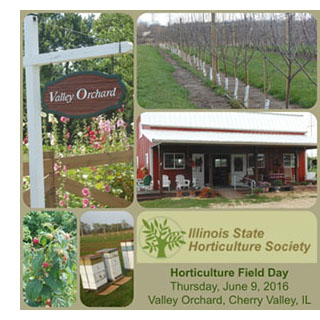 2016 Illinois Commercial Tree Fruit Twilight Meeting, Thursday, May 19, 2016, 5:30 p.m. Joe Ringhausen Apple Orchard & Apple House Market, 19770 US Hwy 67, Jerseyville, IL 62052. For more information and to register visit https://web.extension.illinois.edu/registration/?RegistrationID=14319 or contact Andrew Holsinger at 217-532-3941 or aholsing@illinois.edu.
2016 Illinois Commercial Tree Fruit Twilight Meeting, Thursday, May 19, 2016, 5:30 p.m. Joe Ringhausen Apple Orchard & Apple House Market, 19770 US Hwy 67, Jerseyville, IL 62052. For more information and to register visit https://web.extension.illinois.edu/registration/?RegistrationID=14319 or contact Andrew Holsinger at 217-532-3941 or aholsing@illinois.edu.- Strawberry Field Night, Wednesday May 25, 2016 5:30 – 8:30 p.m. (Eastern Time). OSU South Centers, 1864 Shyville Rd. Piketon, OH. Topics to be covered will include: winter protection techniques, israeli drip irrigation demonstration and management, fertigation and nitrogen management, row cover management, June bearing, day-neutral, ever-bearing cultivar evaluations, pest and disease control, Integrated Pest Management (IPM) techniques, petiole sap analysis demonstration. Cost $20 and pre-registration is required. To Register Conatct Charissa Gardner at Gardner.1148@osu.edu or 740-289-2071 ext.132
- ISHS Summer Horticulture Day, Thursday, June 9, 8:00 a.m. Hosted by Raoul & Jodie Bergersen, Valley Orchard, 811 E State St, Cherry Valley, IL 61016. To register online visit https://www.picatic.com/ilhortday or contact Rachel Graham Coventry at 217-853-6048 or ilsthortsoc@gmail.com
- Illinois Pumpkin Field Day, Wednesday, August 31. Ewing Demonstration Center, 16132 N. Ewing Rd; Ewing, IL 62836. For more information, contact Nathan Johanning at 618-687-1727 or njohann@illinois.edu
Cooperators for Pest Survey
The Illinois Cooperative Agriculture Pest Survey program, in collaboration with the Illinois Department of Agriculture and USDA Division of Plant Protection and Quarantine (PPQ), is conducting this survey as part of the state of Illinois' exotic and invasive species' program. The intent of this survey is to provide an overview and early warning system of invasive pests that if introduced and established in Illinois would be potentially devastating to the specialty crops industry.
This summer we will be conducting surveys in Illinois orchards and vineyards with funding received through the USDA Farm Bill. This is our second year of our orchard survey and our initial year surveying grapes. Both surveys are focused on several invasive pests we feel are a threat to the Illinois grape and specialty crops industries.
As with any commodity there are several pests that can potentially affect grape production. Included in these potential pests are several invasive species that, while not currently not found in Illinois, could greatly impact the Illinois grape industry. The Egyptian cottonworm has a wide host range that include grapes. The European grapevine moth, found in California, and the European grape berry moth are also concerns of grape growers, as is the spotted lantern fly that was recently found in Pennsylvania. Given this new discovery of the spotted lantern fly and its affinity for grapes, it would be of the best interest of the state to include spotted lantern fly in this commodity survey. Phytoplasma Yellows pose a large risk to plant health. Determining their presence/absence in Illinois will also be a benefit to the grape industry.
Included in the orchard survey are several invasive species that are not currently found in Illinois, but could greatly impact this industry. Most of the survey targets are included on the USDA-APHIS-PPQ Priority List for Stone Fruit Commodity. Light brown apple moth and false codling moth are among those and are included as survey targets. As a state, the brown marmorated stink bug and spotted wing drosophila are high ranking in our pests of state concern. The brown marmorated stink has been confirmed in 26 Illinois counties and suspected in many more. We are not only interested in determining its distribution across the state, but also monitoring its movement into agricultural commodities. It has been present in Illinois since 2010 with minimal reported damage to date, but we suspect some areas will start seeing injury in agricultural settings in the near future. Early detection and population monitoring data would help in locating these potential areas, as well as aid in management options. Spotted wing drosophila was confirmed in Illinois in 2011. This new pest is of great interest to the specialty crops growers and while suspected to be present throughout much of the state, this has not been confirmed.
We are wanting to identify 20 vineyards and 20 orchards in Illinois to participate in the surveys. Your involvement requires only permission to place traps in areas around your property. These traps will be clearly marked. All activities related to trap placement, monitoring, and removal are the sole responsibility of the trapping program. Biweekly visits to the property to check traps and lures will occur throughout the summer. Traps would remain in place until September.
In the interest of time (and space in the newsletter), I'd be happy to talk about participating in these projects with anyone that might be interested. Please feel free to call my office or email.
Kelly Estes, State Survey Coordinator, Illinois Cooperative Agricultural Pest Survey (217-333-1005; kcook8@illinois.edu)
Regional Reports
From southern Illinois ... Overall, the last two weeks have been rather cool and very wet. Last week here in Murphysboro we had 3.2" of rain over a 4 day time span with an additional 1.5" so far this week. At home at the farm in southern Monroe County we had almost 5" of rain last week. In addition, there was quite a bit of severe weather that hit various parts of southern Illinois, bringing very strong winds and hail. We are just on our way out of our "Blackberry Winter" with most of our main blackberry varieties in full bloom. We have had highs over the weekend and first of this week in the upper 50s to around 60s and some lows dipping to 40 or a bit below a few mornings. The forecast predicts temperatures increasing to highs around 80 by the weekend so hopefully those temperatures and more sunshine will prevail.

Photo: B. Aly
Overall, the cool weather has slowed the growth of our summer crops like tomatoes and sweet corn. There have been challenges getting recent plantings of sweet corn to come up and current plantings have had very limited growth. One grower technique that has helped keep the sweet corn growing is putting plants out on black plastic as seen in the picture to the left. Also, plant growth regulator herbicide (ie, 2,4-D, dicamba) drift has also be showing up on tomatoes, especially. Our "up and down" temperatures and winds over the last few weeks have probably made that a little worse as well; (see the article later in this issue for more on this topic). Also, development of fruit crops has also been slow. This has been especially problematic in apples as the slow growth has resulted in reduced efficacy of apple thinning sprays applied and growers have to follow up with plant growth regulator type thinning products to "clean up" where the sprays with the carbamate insecticides have not been adequate.
The severe weather last week did leave its mark on some parts of southern Illinois. At home at the farm (southern Monroe County) we were "lucky" enough to be in the midst of a band of hail with the largest hail stones approaching golf ball sized. The storm fortunately did not cause any damage buildings or equipment, but it did do a number on many crops. Apples and pears got their calyxes handed to them along with peaches, nectarines, cherries and blueberries, which were also very beat up. Many of the fruits were damaged enough that they will probably decay and fall off. What remains will have poor quality visually, but we should still get some limited harvest at least for home use. Some green shoots were broke out of table grapes (free shoot thinning!?), but I don't know that there was any fruit injury. Potatoes were beat up with many shoots snapped of and rather battered and corn leaves tattered. Although they didn't look pretty, I think don't think either will have any lasting injury. It did dry up enough Sunday that I was able to sidedress nitrogen, hill/cultivate, and apply a residual herbicide to the potatoes. They often get damaged a little with the cultivator so I figured no need in letting them regrow and beat them up again; just get it all over with now! Lettuce and especially spinach also had tattered leaves. Back closer to Murphysboro, I did hear some growers observing some occasional minor injury from hail to some tree fruit but nothing that severe or widespread. Just some little reminders that in the end Mother Nature is still in charge!
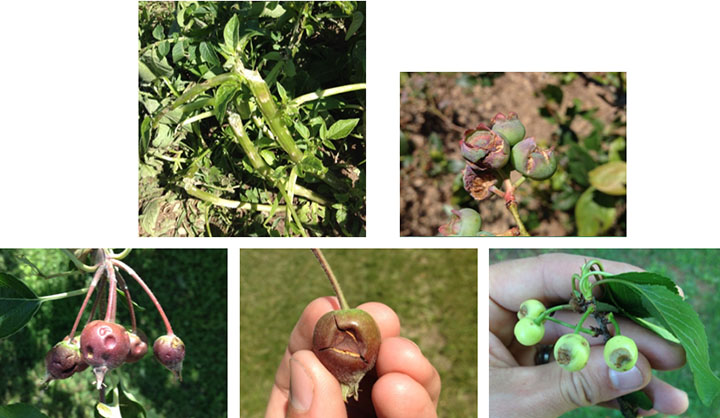
Hail injury on potatoes, blueberries, apples, & cherries. Photos: N. Johanning
Nathan Johanning (618-939-3434; njohann@illinois.edu)
Fruit Production and Pest Management
Rednecked Cane Borer and other Cane and Crown Borers in Brambles
Several days ago Bronwyn Aly texted me photos of rednecked cane borer damage on blackberry canes, so it may be a good time to do the annual review on this insect and related borers in brambles.
Rednecked cane borer is a beetle; the adult stage is known as a metallic wood boring beetle, and larvae are called flat-headed wood borers. It has a 1-year life cycle. Beetles feed on leaf margins from May through August and lay eggs in bark of new growth, usually within 10 inches of the base of canes. Larvae tunnel through canes and reach full size by fall. They pupate in the spring, and adults emerge in May. Damage to canes is characterized by tunnels that spiral around the cane and by symmetrical swellings or galls 1-4 feet above the soil line. Pruning out and destroying galled canes in early spring is recommended for rednecked cane borer control. If more than 5% of canes are galled, a postbloom drench application of Admire Pro to soil for systemic uptake and control may be warranted. Do not apply Admire Pro prebloom or during bloom. Brigade applied to the base of canes when adults are active will give some adult control ... to avoid bee kill, do not apply when plants are in bloom and bees are foraging.
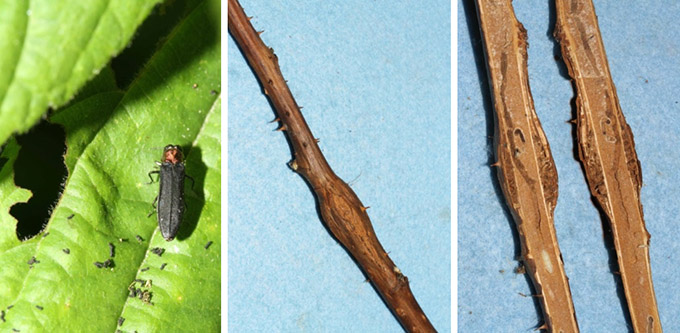
Left: Rednecked cane borer adult and feeding damage on foliage. Center: Gall caused by rednecked cane borer larva. Right: Tunneling inside cane by rednecked cane borer larva. (Photos by Phil Nixon)
A somewhat similar insect, raspberry cane borer, is a longhorned beetle; the larval stage is known as a round-headed wood borer. Raspberry cane borer has a 2-year life cycle. Beetles feed on canes from June through August, and they lay eggs between rings of punctures on canes. Larvae tunnel to the base of canes by fall. They feed in crowns during their second summer, then pupate the following spring; adults emerge from June through August. To control raspberry cane borer, prune out and destroy infested canes, beginning in July. Foliar sprays of insecticides labeled against other bramble pests (including Brigade and Sevin) give some control of adults from late May until mid-July, but applications must be timed to avoid bee kill.

Raspberry cane borer adult, girdling and egg-laying puncture, wilted cane, and larva. (Photos from NRAES-35, Bramble Production Guide)
A third borer in brambles is the raspberry crown borer. It is a clear-winged moth, and its larval stage is a caterpillar with fleshy abdominal prolegs that bear hook-like "crochets." It also has a 2-year life cycle. Moths fly from August through September and lay their eggs on the undersides of leaves; eggs hatch in September and October and move down the canes to the crown. In their first fall, larvae form a hibernaculum below the soil line; they girdle canes and crowns the next summer before wintering in roots. They finish development and pupate in the second summer. To control this insect, apply a drench of Altacor, Brigade, or Hero to the crowns in a minimum of 50 gallons of water per acre after egg hatch in October or November or in late March. Time the application to precede irrigation or a significant rainfall. Biological control by drench application of insect-pathogenic nematodes (Steinernema feltiae) also is possible. Removing infested crowns is also recommended.
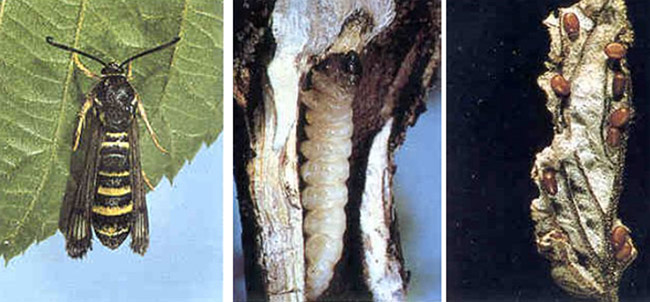
Raspberry crown borer adult, larva, and eggs. (Photos from NRAES-35, Bramble Production Guide)
For more information on these insects and listings of insecticides registered to control them, check the 2016 Midwest Fruit Pest Management Guide.
Rick Weinzierl (217-244-2126; weinzier@illinois.edu)
Eastern Flower Thrips on Strawberries
Quick reminder ... as strawberries bloom and berries begin to enlarge, they are vulnerable to damage from feeding by eastern flower thrips. The eastern flower thrips is a tiny, yellow to brown insect less than 1/16 inch long. Adults are attracted to flowers of many different plants; their rasping feeding causes premature wilting of flower parts and blossom drop, as well as fruit deformities in some crops. Although this insect does not overwinter outdoors in Illinois, survival in greenhouses is presumed to occur, and populations develop each year throughout the state as a result of long-distance migrations from southern states on high-level winds associated with weather fronts. Immigration of thrips may occur simultaneously with immigration of the potato leafhopper.
To determine whether or not thrips control is warranted, strawberry growers should begin sampling for thrips by examining early flower clusters on early varieties and continue sampling all varieties as they begin to bloom. Tap flowers onto a white or very dark plate or saucer, and look for the slender yellow thrips. Alternatively, flower blossoms can be placed into a zip lock bag and shaken to dislodge thrips and allow counting. Although the relationship between thrips density and damage appears to be influenced by variety and weather conditions, control is probably warranted if populations exceed 2-10 thrips per blossom. This is a broad range of densities, but more a more precise threshold has not been established. If insecticides are to be used for thrips control, make applications before bloom is well underway (by the time 10 percent of the plants have open blossoms) to avoid killing pollinators. Entrust (1) and Radiant (1) are labeled for thrips control in strawberries. Lorsban (21), Danitol (2), and Brigade (0) are not labeled specifically for thrips control in strawberries but have been effective in field use at rates listed for clipper or spittlebug and tarnished plant bug; numbers in parentheses indicate the minimum preharvest interval (PHI) that must elapse between the last application of each insecticide and the harvest of fruit. For more details, see the 2016 Midwest Fruit Pest Management Guide.
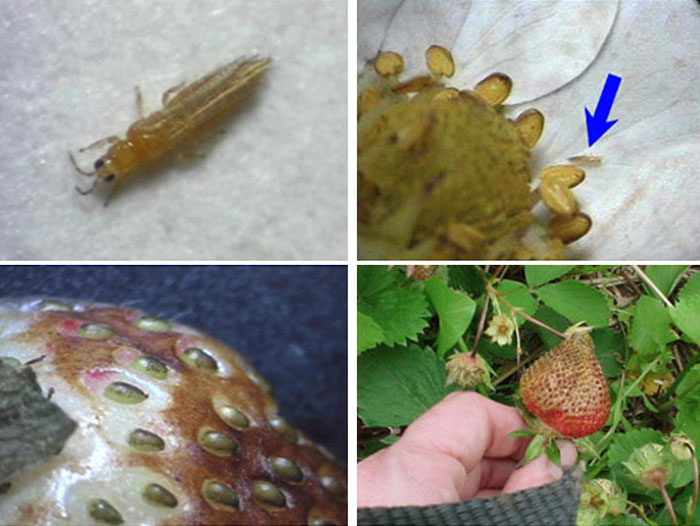
Top left: Adult eastern flower thrips; top right: thrips (at arrow) in strawberry blossom; bottom left: close-up of berry discoloration; bottom right: partially browned berry, likely caused by earlier feeding by eastern flower thrips. (Photos by Elizabeth Wahle)
Rick Weinzierl (217-244-2126; weinzier@illinois.edu)
Potato Leafhopper on Apples

Left to right: cupping of apple leaves as a result of potato leafhopper feeding, potato leafhopper nymph, and adult.
Last week I received a text from southern IL that included a photo of what appeared to be potato leafhoppers on apple leaves ... and this is roughly the time of the season when we expect potato leafhoppers to migrate into Illinois from the south on weather fronts. They feed on a wide range of fruit, vegetable, field crop, and landscape plants by inserting their needle-like mouthparts (stylets) into leaves and shoots, then sucking out plant fluids. In the process, they inject a salivary toxin into the leaves or shoots, causing a variety of symptoms, all of which are sometimes referred to as hopper burn. In apples, potato leafhopper feeding causes cupping of new leaves and greatly reduced growth of new shoots. In most years, potato leafhopper damage is most common in young trees that are not yet bearing fruit, as growers are not spraying them regularly for other insect pests (and coincidentally killing potato leafhopper). In addition, the switch from organophosphates such as Imidan and Guthion to alternatives such as Altacor, Rimon, and Delegate for codling moth control in apples allows potato leafhopper infestations to develop in fruit-bearing blocks, because these insecticides do not control potato leafhoppers.
Sample for potato leafhoppers by examining the undersides of leaves. Look for light-green, narrow, small (< 1/8 inch long) insects that tend to move sideways (instead of forward or backward) when disturbed. Thresholds suggested for potato leafhopper control range from treating whenever adults and nymphs are found on young trees to 1 adult or nymph per leaf on older trees where vigorous new growth is less important. Unlike white apple leafhopper (which is resistant to several insecticides), potato leafhopper is susceptible to most of the broad-spectrum insecticides used in apples –Imidan, neonicotinoids such as Assail and Calypso, pyrethroids such as Danitol (and others), and carbamates such as Lannate and Sevin. Again, Altacor, Belt, Delegate, and Rimon do not control potato leafhopper.
Rick Weinzierl (217-244-2126; weinzier@illinois.edu)
Vegetable Production and Pest Management
"Worms" on Cabbage and Related Brassica Family Plants
My annual review of the most common "worms" on cabbage family plants ...
Imported cabbage worm overwinters as a pupa within a chrysalis in crop debris, and adults -- the common white cabbage butterflies -- begin flying in early spring. They have been on the wing for a few weeks now in much of the state. They lay bullet-shaped, ridged yellow eggs (individually, not in masses) on foliage. Larvae are velvet-green, and just over 1 inch long when fully grown; they tend to feed from the edges of the leaf, and large veins are left intact. The chrysalis that encloses the pupa is grayish green to bright green and suspended by threads from the underside of outer leaves. It usually takes 4 to 5 weeks for larvae to mature from the egg to the adult stage.

Imported cabbage worm larva and adult (cabbage butterfly).
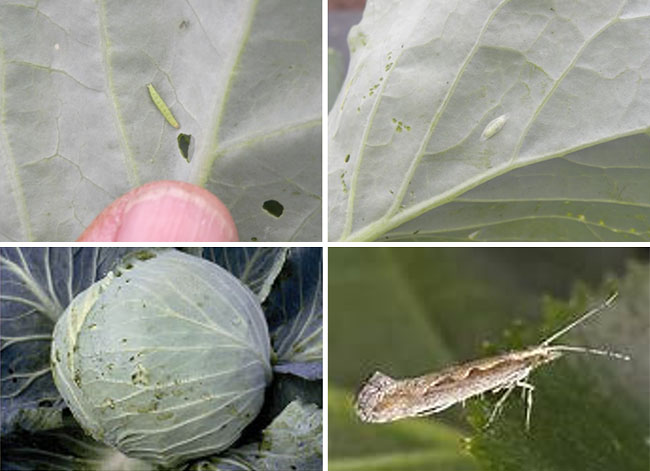
Clockwise from upper left: Diamondback moth larva, pupa, adult, and damage to cabbage.
The diamondback moth is the smallest of these three species. It winters in Illinois as an adult moth, though the portion that survives the winter is low in normal to severe winters. Eggs, larvae, and pupae may be introduced on transplants shipped in from southern regions, and northward migration of moths during the season also can extend its range. Flat, yellowish eggs are laid singly or in small groups, often near leaf veins or on stems, but they usually go unnoticed. Larvae initially mine between leaf surfaces, then they feed externally, often consuming all but the upper or lower epidermis, leaving a "window pane" effect. Fully grown, they are about 3/8 inch long. They pupate within a light silken cocoon on a leaf, and a small moth (1/2-inch wing span) emerges a week or so later. Each generation takes 3 to 4 weeks for growth and development, and there can be as many as 6 generations per year in Illinois.
The cabbage looper is the largest and most destructive of the three common Leps that attack cole crops here. This insect does not overwinter (at least not in significant numbers) in most of the Midwest; instead it migrates into the region on weather fronts, usually from June through September. Moths lay dome-shaped, ridged white eggs singly or in small masses on the underside of leaves. Larvae have only 3 pairs of abdominal prolegs (rear fleshy legs without joints) instead of the "normal" 5 pairs of many common Lepidopteran larvae. They grow to a length of 1 1/4 inch or more, and their feeding on leaves and heads can be very heavy. In addition, their frass (insect poop) is a less-than-sought-after contaminant. Each season, 2 to 3 generations of cabbage loopers develop in most of Illinois.
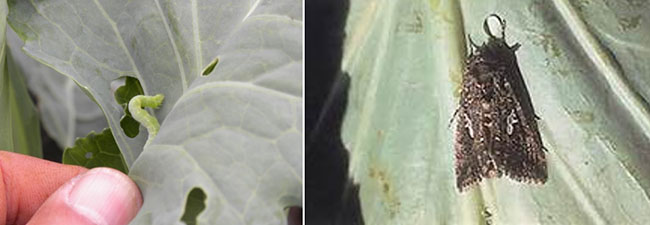
Cabbage looper larva and adult.
The simplest thresholds (and therefore the ones most often used by growers who scout their own fields) for these insects lump all species together, at least for determining the need for control. Growers should examine 10 plants per site in each of 10 sites in a field (more samples = more dependable conclusions), record each plant as infested (by any of the species) or uninfested, and use the following thresholds.
Thresholds for imported cabbage worm, diamondback moth, and cabbage looper: treat if infestations of any/all of the 3 species are found on more than the percentage of plants listed below. |
|
Crop and Stage |
Percent |
Broccoli and cauliflower |
|
Cabbage |
|
Collards, Kale, Mustard Greens, and Turnip Greens |
|
Early in the season, whenever control of flea beetles, aphids, and thrips is NOT needed, use Bt (Bacillus thuringiensis) applications to control these Lepidopteran larvae on crucifers. Bt products include Agree, Biobit, Dipel, Javelin, Lepinox, XenTari, and others. These Bt preparations must be eaten by caterpillars to be effective, and they are toxic only to larvae of butterflies and moths. They work well against imported cabbage worm and diamondback moth larvae and are effective enough against young cabbage looper larvae to keep most infestations below economic thresholds at least until heads are forming or present. Relying as much as possible on Bt products early in the season avoids killing natural enemies that help to keep these pests (especially diamondback moth) under control; it also reduces selection for resistance, especially in the diamondback moth, to pyrethroids and a few other insecticides that are valuable for use as cleanup sprays near harvest. Several insecticides are labeled for use against these pests in cole crops (cabbage, broccoli, etc.), but the list of included versus excluded crops gets pretty complex for leafy greens. Check the 2016 Midwest Vegetable Production Guide and product labels for specific listings. Where populations of diamondback moth show resistance to pyrethroids (or even to Bt), products with different modes of action include Avaunt, Coragen, Entrust, Intrepid, Proclaim, Radiant, and Rimon. Entrust is the OMRI-listed formulation of spinosad that can be used in organic production systems.
Also remember ... Flea beetles can be damaging especially on seedlings and leafy greens. A number of insecticides are effective for their control; see the 2016 Midwest Vegetable Production Guidefor a listing of effective insecticides. Onion thrips often move into cabbage as surrounding small grain fields dry down. Thrips are difficult to control in cabbage after they move between wrapper leaves. The time to treat is often at cupping or as heads begin to form. Brigade, Entrust, Mustang Max, Radiant, and Warrior are among the insecticides that are effective against onion thrips in cabbage.
Rick Weinzierl (217-244-2126; weinzier@illinois.edu)
Potato Leafhopper on Green Beans and Potatoes
As noted above under the Fruit heading, now is the time to expect potato leafhopper immigration from the south on weather fronts. In Illinois vegetable crops, potato leafhopper is particularly damaging to potatoes and green beans. As it feeds by inserting its stylet into leaves and sucking out plant fluids, it also injects its saliva into the plant. The saliva is toxic to plants, and leaves typically yellow and curl and plant growth is stunted. See the 2016 Midwest Vegetable Production Guide for listings of registered insecticides.

Potato leafhoppers and injury to potato and green bean leaves. (Photos, L to R, are from Michigan State University, Penn State University, and the University of Massachusetts.)
Rick Weinzierl (217-244-2126; weinzier@illinois.edu)
2016 Watermelon and Cantaloupe Variety Trials at Southwest Purdue Agricultural Center
Every year since 1980, we have conducted watermelon and cantaloupe variety trials at Southwest Purdue Agricultural Center. In 2016, our variety trials include 44 standard seedless watermelons, 12 cantaloupes, 4 mini-sized seedless watermelons, and 5 seeded watermelon varieties. Seeds have already been planted in the greenhouses and our target date for transplanting in the field will be the week of May 9th. The fruit will become ripe around the middle of July. If you are interested in observing how each variety performs during the season, don't hesitate to come to visit us and witness the plots first hand.
We will continue to present the results of our variety trials, as in the past, at the annual meeting held at the Southwest Purdue Ag Center in late November or early December but don't miss the opportunity to visualize them during the growing season. In the winter meeting, we will discuss yield and fruit quality (sugar content, flesh firmness, hollow heart etc.) of these varieties. Please watch for the announcement that will be sent out later this year as to the exact date. Below is a list of the varieties that will be in our trails this year. We also want to give special thanks to the seed companies that continue to support our research here at the Southwest Purdue Ag Center this year and in the years past.
Click here to view the complete list of varieties. To visit the trial, please contact Wenjing Guan at guan40@purdue.edu, or (812)886-0198.
Wenjing Guan, Clinical/Engagement Assistant Professor, Southwest Purdue Agricultural Center, Purdue University (812-886-0198; guan40@purdue.edu)
Herbicide Injury on Tomato Plants
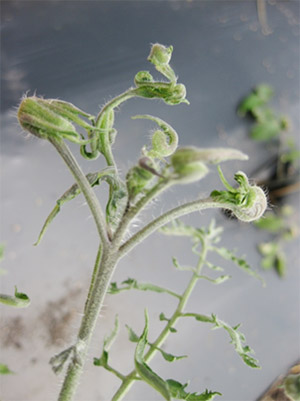 On the week of May 9, Cook County Extension Office received samples of high tunnel tomato plants that had the symptoms shown in the picture. The damage looks much like that which could be caused by herbicide drift (probably vapor drift) from some kind of a plant growth regulator such as 2,4-D or dicamba. These herbicides are systemic, first affect the new growth, causing leaf curling, twisting, and epinasty (increased growth on upper surface). Under the right conditions (especially very warm/above 85˚/hot weather) the vapor can drift far, sometimes more than a mile. Also, these herbicide active ingredients can be found in many broadleaf lawn herbicides and brush killers. Vapor drift is often worse on very warm days, which is also when high tunnels will be opened to vent excess heat. Pesticide applicators should be precautious of use of highly volatile herbicides such as these, during high temperatures to reduce the potential for vapor drift and be considerate of sensitive crops in the area.
On the week of May 9, Cook County Extension Office received samples of high tunnel tomato plants that had the symptoms shown in the picture. The damage looks much like that which could be caused by herbicide drift (probably vapor drift) from some kind of a plant growth regulator such as 2,4-D or dicamba. These herbicides are systemic, first affect the new growth, causing leaf curling, twisting, and epinasty (increased growth on upper surface). Under the right conditions (especially very warm/above 85˚/hot weather) the vapor can drift far, sometimes more than a mile. Also, these herbicide active ingredients can be found in many broadleaf lawn herbicides and brush killers. Vapor drift is often worse on very warm days, which is also when high tunnels will be opened to vent excess heat. Pesticide applicators should be precautious of use of highly volatile herbicides such as these, during high temperatures to reduce the potential for vapor drift and be considerate of sensitive crops in the area.
When injury does occur, determining whether to keep or replace plants can be a challenge. Determining factors include, but are not limited to; extent of damage, maturity of crop, assessment of new growth, and availability of replacement plants. Damaged plants can remain unproductive depending on severity of exposure and growing conditions. If damage happens early in the season, a new planting can often overtake and exceed those stunted plants. Tomatoes grown in high tunnels are susceptible anytime the sides are opened for ventilation and temperature control.
Kim Ellson, Horticulture Educator, Cook County (847-818-2901; kellson@illinois.edu)
Food Safety Updates
Produce Safety Rule: COMPLIANCE DATES & SPROUT PRODUCTION – article 7 of 7
Compliance dates for covered activities, except for those involving sprouts, after the effective date of the final rule are:
- Very small businesses, those with more than $25,000 but no more than $250,000 in average annual produce sales during the previous three year period : four years
- Small businesses, those with more than $250,000 but no more than $500,000 in average annual produce sales during the previous three year period: three years
- All other farms: two years
- The compliance dates for certain aspects of the water quality standards, and related testing and recordkeeping provisions, allow an additional two years beyond each of these compliance dates for the rest of the final rule
Compliance dates for modified requirements for farms eligible for a qualified exemption are:
- For labeling requirement (if applicable): January 1, 2020
- For retention of records supporting eligibility for a qualified exemption: Effective date of the final rule
- For all other modified requirements:
- Very small businesses, four years after the effective date of the final rule
- Small businesses, three years after the effective date of the final rule
SPROUT PRODUCTION
The final rule includes new requirements to help prevent the contamination of sprouts. Sprouts are especially vulnerable to dangerous microbes because of the warm, moist and nutrient-rich conditions needed to grow them.
Sprout requirements include:
- Treating seed and beans before sprouting
- Testing spent sprout irrigation water (or sprouts, in some cases) from each production batch of sprouts, or in-process sprouts from each production batch, for certain pathogens
- Monitor/test the growing, harvesting, packing, and holding environment for Listeria species or Listeria monocytogenes, and testing each production batch of spent sprout irrigation water or sprouts for E. coli O157:H7, Salmonella species, and other pathogens, taking appropriate follow-up actions
- Discontinuing use of seeds or beans when spent irrigation water (or sprouts) is associated with a foodborne illness or a positive pathogen finding
The final rule states:
- Sprout operations will have less time to come into compliance with the rule than farms growing other produce. There will be staggered compliance dates based on operation size, to begin one (1) year after the effective date of the rule; there will be no additional time to meet the water requirements
- Establish a written sampling plan and a corrective action plan for testing of spent irrigation water (or sprouts)
- Requirement of certain records, including documentation of treatment of seeds or beans for sprouting, a written environmental monitoring plan and sampling plan, test results, certain test methods used, and corrective actions.
- New provisions to prevent contaminated produce entering commerce (including "hold-and-release" – must not allow sprouts to enter commerce until negative pathogen testing results are received)
Compliance dates for covered activities involving sprouts after the effective date of the final rule are:
- Very small businesses - those with more than $25,000 but no more than $250,000 in average annual produce sales during the previous three year period: three years
- Small businesses - those with more than $250,000 but no more than $500,000 in average annual produce sales during the previous three year period: two years
- All other farms: one year
QUESTIONS/COMMENTS:
The Food and Drug Administration has established a Food Safety Technical Assistance Network to provide a central source of information to support industry understanding and implementation:
http://www.fda.gov/Food/GuidanceRegulation/FSMA/ucm459719.htm
Laurie George (618-548-1446; ljgeorge@illinois.edu)
Less Seriously ...
A farmer got sent to jail. His wife was trying to hold the farm together until her husband could get out. She wrote a letter to him in jail, "Dear Hubby, I want to plant the squash. When is the best time to do that?" The farmer wrote back: "Honey, don't go near that field. That's where all my money and drugs are hidden." All of the farmer's mail was censored, since he was in jail. So when the sheriff and his deputies read the letter, they all ran out to the farm and dug up the entire potato field looking for the drugs and cash. After two full days of digging, they didn't find anything. The farmer then wrote to his wife; "Honey, now is when you should plant the squash."
Funniestcleanjokes.com – Farmer in Jail Joke
University of Illinois Extension Specialists in Fruit and Vegetable Production & Pest Management
Extension Educators – Local Food Systems and Small Farms |
||
Bronwyn Aly, Gallatin, Hamilton, Hardin, Pope, Saline, and White counties |
618-382-2662 |
|
Katie Bell, Franklin, Jackson, Perry, Randolph, & Williamson counties |
618-687-1727 |
|
Sarah Farley, Lake & McHenry counties |
847-223-8627 |
|
Nick Frillman, Woodford, Livingston, & McLean counties |
309-663-8306 |
|
Laurie George, Bond, Clinton, Jefferson, Marion, & Washington counties |
618-548-1446 |
|
Zachary Grant, Cook County | 708-679-6889 | |
Doug Gucker, DeWitt, Macon, and Piatt counties |
217-877-6042 |
|
Erin Harper, Champaign, Ford, Iroquois, and Vermillion counties |
217-333-7672 |
|
Grace Margherio, Jackie Joyner-Kersee Center, St. Clair County |
217-244-3547 |
|
Grant McCarty, Jo Daviess, Stephenson, and Winnebago counties |
815-235-4125 |
|
Katie Parker, Adams, Brown, Hancock, Pike and Schuyler counties |
217-223-8380 |
|
Kathryn Pereira, Cook County |
773-233-2900 |
|
James Theuri, Grundy, Kankakee, and Will counties |
815-933-8337 |
|
Extension Educators – Horticulture |
||
Chris Enroth, Henderson, Knox, McDonough, and Warren counties |
309-837-3939 |
|
Richard Hentschel, DuPage, Kane, and Kendall counties |
630-584-6166 |
|
Andrew Holsinger, Christian, Jersey, Macoupin, & Montgomery counties |
217-532-3941 |
|
Extension Educators - Commercial Agriculture |
||
Elizabeth Wahle, Fruit & Vegetable Production |
618-344-4230 |
|
Nathan Johanning, Madison, Monroe & St. Clair counties |
618-939-3434 |
|
Campus-based Extension Specialists |
||
Kacie Athey, Entomology |
217-244-9916 |
|
Mohammad Babadoost, Plant Pathology |
217-333-1523 |
|